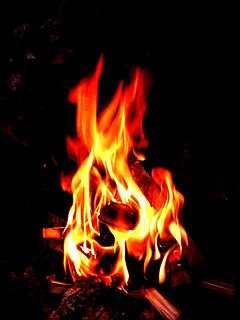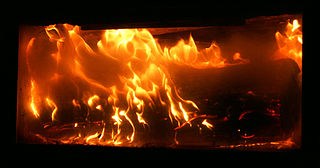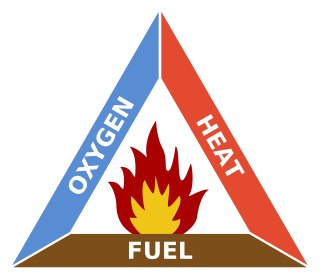
Combustion, or burning, is a high-temperature exothermic redox chemical reaction between a fuel and an oxidant, usually atmospheric oxygen, that produces oxidized, often gaseous products, in a mixture termed as smoke. Combustion doesn't always result in fire, but when it does, a flame is a characteristic indicator of the reaction. While the activation energy must be overcome to initiate combustion, the heat from a flame may provide enough energy to make the reaction self-sustaining. Combustion is often a complicated sequence of elementary radical reactions. Solid fuels, such as wood and coal, first undergo endothermic pyrolysis to produce gaseous fuels whose combustion then supplies the heat required to produce more of them. Combustion is often hot enough that incandescent light in the form of either glowing or a flame is produced. A simple example can be seen in the combustion of hydrogen and oxygen into water vapor, a reaction commonly used to fuel rocket engines. This reaction releases 242 kJ/mol of heat and reduces the enthalpy accordingly :
In engineering and science, dimensional analysis is the analysis of the relationships between different physical quantities by identifying their base quantities and units of measure and tracking these dimensions as calculations or comparisons are performed. The conversion of units from one dimensional unit to another is often easier within the metric or SI system than in others, due to the regular 10-base in all units. Dimensional analysis, or more specifically the factor-label method, also known as the unit-factor method, is a widely used technique for such conversions using the rules of algebra.
The gas constant is denoted by the symbol R or R. It is equivalent to the Boltzmann constant, but expressed in units of energy per temperature increment per mole, i.e. the pressure–volume product, rather than energy per temperature increment per particle. The constant is also a combination of the constants from Boyle's law, Charles's law, Avogadro's law, and Gay-Lussac's law. It is a physical constant that is featured in many fundamental equations in the physical sciences, such as the ideal gas law and the Nernst equation.

Physical properties of materials and systems can often be categorized as being either intensive or extensive, according to how the property changes when the size of the system changes. According to IUPAC, an intensive quantity is one whose magnitude is independent of the size of the system whereas an extensive quantity is one whose magnitude is additive for subsystems. This reflects the corresponding mathematical ideas of mean and measure, respectively.

A flame is the visible, gaseous part of a fire. It is caused by a highly exothermic reaction taking place in a thin zone. Very hot flames are hot enough to have ionized gaseous components of sufficient density to be considered plasma.
In fluid dynamics, the Darcy–Weisbach equation is an empirical equation, which relates the head loss, or pressure loss, due to friction along a given length of pipe to the average velocity of the fluid flow for an incompressible fluid. The equation is named after Henry Darcy and Julius Weisbach.

Deflagration is subsonic combustion propagating through heat transfer; hot burning material heats the next layer of cold material and ignites it. Most "fires" found in daily life, from flames to explosions such as that of black powder, are deflagrations. This differs from detonation, which propagates supersonically through shock waves, decomposing a substance extremely quickly.
The autoignition temperature or kindling point of a substance is the lowest temperature at which it spontaneously ignites in normal atmosphere without an external source of ignition, such as a flame or spark. This temperature is required to supply the activation energy needed for combustion. The temperature at which a chemical ignites decreases as the pressure or oxygen concentration increases. It is usually applied to a combustible fuel mixture.

The fire triangle or combustion triangle is a simple model for understanding the necessary ingredients for most fires.
In atomic physics, the electron magnetic moment, or more specifically the electron magnetic dipole moment, is the magnetic moment of an electron caused by its intrinsic properties of spin and electric charge. The value of the electron magnetic moment is approximately −9.284764×10−24 J/T. The electron magnetic moment has been measured to an accuracy of 7.6 parts in 1013.

Wetting is the ability of a liquid to maintain contact with a solid surface, resulting from intermolecular interactions when the two are brought together. The degree of wetting (wettability) is determined by a force balance between adhesive and cohesive forces. Wetting deals with the three phases of materials: gas, liquid, and solid. It is now a center of attention in nanotechnology and nanoscience studies due to the advent of many nanomaterials in the past two decades.

A premixed flame is a flame formed under certain conditions during the combustion of a premixed charge of fuel and oxidiser. Since the fuel and oxidiser—the key chemical reactants of combustion—are available throughout a homogeneous stoichiometric premixed charge, the combustion process once initiated sustains itself by way of its own heat release. The majority of the chemical transformation in such a combustion process occurs primarily in a thin interfacial region which separates the unburned and the burned gases. The premixed flame interface propagates through the mixture until the entire charge is depleted. The propagation speed of a premixed flame is known as the flame speed which depends on the convection-diffusion-reaction balance within the flame, i.e. on its inner chemical structure. The premixed flame is characterised as laminar or turbulent depending on the velocity distribution in the unburned pre-mixture.
National Fire Danger Rating System (NFDRS) is used in the United States to provide a measure of the relative seriousness of burning conditions and threat of fire.
In astrophysics, the nuclear timescale is an estimate of the lifetime of a star based solely on its rate of fuel consumption. Along with the thermal and free-fall time scales, it is used to estimate the length of time a particular star will remain in a certain phase of its life and its lifespan if hypothetical conditions are met. In reality, the lifespan of a star is greater than what is estimated by the nuclear time scale because as one fuel becomes scarce, another will generally take its place—hydrogen burning gives way to helium burning, etc. However, all the phases after hydrogen burning combined typically add up to less than 10% of the duration of hydrogen burning.

Diffusion is the net movement of anything from a region of higher concentration to a region of lower concentration. Diffusion is driven by a gradient in concentration.

In computational science, wildfire modeling is concerned with numerical simulation of wildland fires in order to understand and predict fire behavior. Wildfire modeling can ultimately aid wildland fire suppression, namely increase safety of firefighters and the public, reduce risk, and minimize damage. Wildfire modeling can also aid in protecting ecosystems, watersheds, and air quality.
The energy release component (ERC) is a number related to the available energy (BTU) per unit area within the flaming front at the head of a fire. Daily variations in ERC are due to changes in moisture content of the various fuels present, both live and dead. Since this number represents the potential "heat release" per unit area in the flaming zone, it can provide guidance to several important fire activities. It may also be considered a composite fuel moisture value as it reflects the contribution that all live and dead fuels have to potential fire intensity. The ERC is a cumulative or "build-up" type of index. As live fuels cure and dead fuels dry, the ERC values get higher, thus providing a good reflection of drought conditions. The scale is open-ended or unlimited and, as with other NFDRS components, is relative. Conditions producing an ERC value of 24 represent a potential heat release twice that of conditions resulting in an ERC value of 12.
In combustion engineering and explosion studies, the Markstein number characterizes the effect of local heat release of a propagating flame on variations in the surface topology along the flame and the associated local flame front curvature. The dimensionless Markstein number is defined as:
Liñán diffusion flame theory is a theory developed by Amable Liñán in 1974 to explain the diffusion flame structure using activation energy asymptotics and Damköhler number asymptotics. Liñán used counterflowing jets of fuel and oxidizer to study the diffusion flame structure, analyzing for the entire range of Damköhler number. His theory predicted four different type of flame structure as follows,
In combustion, Burke–Schumann limit, or large Damköhler number limit, is the limit of infinitely fast chemistry, named after S.P. Burke and T.E.W. Schumann, due to their pioneering work on Burke–Schumann flame. One important conclusion of infinitely fast chemistry is the non-co-existence of fuel and oxidizer simultaneously except in a thin reaction sheet. The inner structure of the reaction sheet is described by Liñán's equation.











